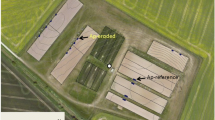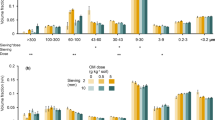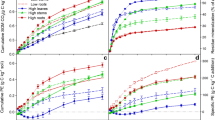Abstract
The aim of our study was to follow the transfer of 14C-labeled ryegrass between size and density fractions of soil organic matter in a sandy and a loam soil. Our hypotheses were a) that the applied 14C would be transferred from light and soluble fractions to intermediate and heavy macroorganic matter fractions (>150 μm) and finally become stabilized in microaggregates (<150 μm), and b) that the physical protection of 14C associated with microaggregates against decomposition would decrease with increasing saturation of the microaggregates with soil organic matter. Generally, the hypotheses were confirmed. Immediately after application most of the label was present in the soluble and light macroorganic matter fractions. Newly synthesized microbial biomass fed on the labeled components of the fractions. The amounts of 14C in the soluble and light macroorganic matter fractions decreased rapidly, while the amounts of 14C in the intermediate and heavy macroorganic matter fractions and in microaggregates remained more or less stable. At the end of the incubation most of the residual soil 14C was found in the microaggregates. In the sandy soil 14C was concentrated in the 20–150 μm fraction, whereas in the loam a larger proportion was present in the <20 μm fraction.
The mineralization rates of 14C-labeled material were similar in the light intermediate and heavy fractions of macroorganic matter and in the microaggregates 0 and 180 days after the application of 14C-labeled ryegrass. In all fractions, 14C mineralized more rapidly than total C. The results indicate that considerable amounts of 14C must have transferred from the soluble and light macroorganic matter fractions and newly synthesized microbial biomass to the intermediate and heavy macroorganic matter fractions and the microaggregates, and that 14C was not yet physically protected against microbial degradation during the whole incubation period. The degree of physical protection of 14C against decomposition in the microaggregate fraction <20 μm was negatively correlated with the degree of saturation of this particle size fraction with soil organic matter.
Similar content being viewed by others
References
Amato M and Ladd J N 1980 Studies of nitrogen immobilization and mineralization in calcareous soils. V. Formation and distribution of isotope-labelled biomass during decomposition of 14C- and 15N-labelled plant material. Soil Biol. Biochem. 12, 405–411.
Amato M and Ladd J N 1992 Decomposition of 14C-labelled glucose and legume materials in soil: properties influencing the accumulation of organic residue C and microbial biomass C. Soil Biol. Biochem. 24, 455–464.
Bonde T A, Christensen B T and Cerri C C 1992 Dynamics of soil organic matter as reflected by natural 13C abundance in particle size fractions of forested and cultivated oxisols. Soil Biol. Biochem. 24, 275–277.
Bremer E and Van Kessel C 1990 Extractability of microbial 14C and 15N following addition of variable rates of labelled glucose and NH42SO4 to soil. Soil Biol. Biochem. 22, 703–713.
Buyanovsky G A, Aslam M and Wagner G H 1994 Carbon turnover in soil physical fractions. Soil Sci. Soc. Am. J. 58, 1167–1173.
Cheshire M V and Mundie C M 1981 The distribution of labelled sugars in soil particle size fractions as a means of distinguishing plant and microbial carbohydrate residues. J. Soil Sci. 32, 605–618.
Christensen B T and Sörensen L H 1985 The distribution of native and labelled carbon between soil particle size fractions isolated from long-term incubation experiments. J. Soil Sci. 36, 219–229.
Elliott E T and Cambardella C A 1991 Physical separation of soil organic matter. Agric. Ecosyst. Environ. 34, 407–419.
Genstat Manual 1987 Genstat. A General Statistical Program. Clarendon Press, Oxford, UK.
Golchin A, Oades J M, Skjemstad J O and Clarke P 1994 Soil structure and carbon cycling. Aust. J. Soil Res. 32, 1043–1068.
Gorissen A, van Ginkel J H, Keurentjes J J B and van Veen J A 1995 Grass root decomposition is retarded when grass has been grown under elevated CO2. Soil Biol. Biochem. 27, 117–120.
Greenland D J and Ford W 1964 Separation of partially humified organic materials from soil by ultrasonic dispersion. Proceedings 8th International Congress of Soil Science, Bucharest, Vol. III. pp 137–148.
Hassink J 1994a Active organic matter fractions and microbial biomass as predictors of N mineralization. Eur. J. Agron. 3, 257–265.
Hassink J 1994b Effects of soil texture and grassland management on soil organic C and N and rates of C and N mineralization. Soil Biol. Biochem. 26, 1221–1231.
Hassink J 1995a Density fractions of soil macroorganic matter and microbial biomass as predictors of C and N mineralization. Soil Biol. Biochem. 27, 1099–1108.
Hassink J 1995b Decomposition rate constants of size and density fractions of soil organic matter. Soil Sci. Soc. Am. J. 59, 1631–1635.
Hassink J 1995c The capacity of soils to preserve organic C and N by their association with clay and silt particles. Soil Sci. Soc. Am. J. (Submitted).
Hassink J 1995d Preservation of plant residues in soils differing in unsaturated protective capacity. Soil Sci. Soc. Am. J. (In press).
Jenny H, Gessel S P and Bingham F T 1949 Comparative study of decomposition rate of organic matter in temperate and tropical regions. Soil Sci. 68, 419–432.
Ladd J N, Parsons J W and Amato M 1977 Studies of nitrogen immobilization and mineralization in calcareous soils-I. Distribution of immobilized nitrogen amongst soil fractions of different particle size and density. Soil Biol. Biochem. 9, 309–318.
Mebius L J 1960 A rapid method for the determination of organic carbon in soil. Anal. Chim. Acta 22, 120–124.
Meijboom F W, Hassink J and van Noordwijk M 1995 Density fractionation of soil macroorganic matter using silica suspensions. Soil Biol. Biochem. 27, 1109–1111.
Nicolardot B, Cheneby D and Allard M R 1992 Availability of carbon and nitrogen contained in different soil particle-size fractions. In Humus, its Structure in Agriculture and Environment. Ed. J Kubat, pp 107–116. Proceedings 15th Symposium Humus et Planta. Elsevier Publishers, Amsterdam, the Netherlands.
Skjemstad J O, Le Feuvre R P and Prebble R E 1990 Turnover of soil organic matter under pasture as determined by 13C natural abundance. Aust. J. Soil Res. 28, 267–276.
Skjemstad J O, Janik L J, Head M J and McClure 5 G 1993 High energy ultraviolet photo-oxidation: a novel technique for studying physically protected organic matter in clay- and silt-sized aggregates. J. Soil Sci 44, 485–499.
Stotzky G 1986 Influence of soil mineral colloids on metabolic processes, growth, adhesion, and ecology of microbes and viruses. In Interactions of Soil Minerals with natural Organics and Microbes. Eds. P M Huang and M Schnitzer. pp 305–428. Soil Sci. Soc. Am., Madison, WI, USA.
Strickland T, Sollins P, Rudd N and Schimel D 1992 Rapid stabilization and immobilization of 15N in forest and range soils. Soil Biol. Biochem. 24, 849–855.
Swift M J, Heal O W and Anderson J M 1979 Decomposition in terrestrial exosystems. Studies in Ecology, Vol 5. Blackwell Scientific Publications, Oxford, UK.
Tiessen J, Stewart J W B and Hunt H W 1984 Concepts of soil organic matter transformations in relation to organo-mineral particle size fractions. Plant and Soil 76, 187–295.
Tisdall J M and Oades J M 1982 Organic matter and water stable aggregates in soils. J. Soil Sci. 33, 141–163.
Vance E D, Brookes P C and Jenkinson D S 1987 An extraction method for measuring soil microbial biomass. Soil Biol. Biochem. 19, 703–707.
Van Cleve K, 1974 Organic matter quality in relation to decomposition. In Soil Organisms and Decomposition in Tundra. Eds. A J Holding, O W Heal, S F Maclean and P W Flanagan. pp 311–324. Tundra Biome Steering Committee, Stockholm, Sweden.
Van Veen J A and Kuikman P J 1990 Soil structural aspects of decomposition of organic matter. Biogeochemistry 11, 213–233.
Van Veen J A, Ladd J N and Frissel M J 1984 Modelling C and N turnover through the microbial biomass in soil. Plant and Soil 76, 257–274.
Wu J, Joergensen R G, Pommerening B, Chaussod R and Brookes P C 1990 Measurement of soil microbial biomass C by fumigation-extraction-an automated procedure. Soil Biol. Biochem. 22, 1167–1169.
Author information
Authors and Affiliations
Rights and permissions
About this article
Cite this article
Hassink, J., Dalenberg, J.W. Decomposition and transfer of plant residue 14C between size and density fractions in soil. Plant Soil 179, 159–169 (1996). https://doi.org/10.1007/BF00009325
Received:
Accepted:
Issue Date:
DOI: https://doi.org/10.1007/BF00009325




